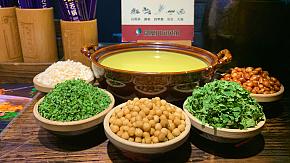Guilin Local Teas
Liubao Tea
Originating in Liubao in Cangwu County, Guangxi Province, Liubao Tea is known as dark tea. When the tea leaves are harvested, they are sprayed with water and covered with tarps to keep the humidity levels high until they have reached the proper level of fermentation. The leaves are then dried and sorted. The tea is packaged in several different ways. Traditionally the tea was packed very tightly in bamboo baskets to make storing and transporting more convenient. Another way that is popular with minority groups is to pack the still-damp tea leaves into a piece of bamboo. The bamboo is held over a fire, and when the tea leaves are dried, they shrink, so more leaves are packed in. This process is continued until the bamboo tube is full. The tea can be stored in the bamboo until it is wanted. Then, the bamboo is split open, and the tea is removed. Another way of packaging the tea is to compress it into cakes. The cakes are flat and can be easily stored. Like most dark teas, Liubao Tea can be stored for many decades and, in fact, ages like wine to become mellower and better tasting. When brewed, the tea liquor is dark red, and the flavor of the tea is very natural with a slight hint of betel nuts and leaves a lasting aftertaste.
 Tea Plantation
Tea Plantation
Guiping Xishan Tea
Guiping Xishan (West Hill) Tea is made in Xishan, which is a famous Buddhist Scenic spot. The tea originates from the Tang Dynasty (618-907). There is a famous poem from that time that states, "Xishan Tea looks clear and smells fragrant, and is as wonderful as Dragon Well Tea." According to local history, the nuns and monks in Xishan Temple took tea seeds from Jiangnan and produced tea in the style of the Jiangnan people. The area of Xishan is located near the Qing River and has ideal conditions for the production of tea. Guiping Xishan Tea has soft blue-green leaves with a bright luster. The brewed tea has a light green tint and is very fragrant, with a long-lasting aftertaste.
Lingyun Baimao Tea
Produced in Lingyun in Guangxi Province, Lingyun Baimao Tea has large elliptical leaves that are dark green in color. When picked, only buds with one leaf are chosen. The back of the leaves is covered with a white down. The taste of Lingyun Baimao Tea is rich and has a slight flowery taste to it. The tea is brewed in glasses, and it is almost mesmerizing to watch the tea dance in the water.
Tantang Maojian Tea
Tantang Maojian Tea is produced in Guangxi's Songbo and Liulu Mountains at a height of more than 1,000 meters. The area has plenty of rain, making it ideal for the production of tea. The process of producing the tea is quite extensive, and over ten steps are required to make the final products. The taste of the brewed tea is very fragrant and clear.
Bainiu Tea
Produced in Bainiu Village in Qinxiu Yao Autonomous County in Guangxi Province, Bainiu Tea was first produced over 100 years ago during the Qing Dynasty (1644-1911). The brewed tea is slightly sweet and clear, with a clear fragrance that leaves drinkers feeling refreshed.
Guilin Maojian Tea
Grown in Guilin, Guangxi Province, Guilin Maojian Tea is one of Guilin's most famous exports. The production of Guilin Maojian Tea is quite complicated. The best tea is picked in March, and the leaves need to be protected from the sun. Directly after picking, the leaves are flattened for 3 to 6 hours. It is finally dried. Guilin Maojian Tea's liquor has a light green tint to it with a strong fragrance.
Guihua (Osmanthus Blossom) Tea
Guilin's name means Osmanthus Grove because of the many Osmanthus trees that can be found throughout the city. When the trees bloom, the entire city is filled with the fragrance of Osmanthus flowers. The procedure for producing Guihua tea is very complex and time-consuming. The blossoms are picked just before they open and the blossoms are added to dry local green tea. The essential oils from the blossoms are drawn into the dried tea leaves. It has to be done under exacting conditions, or the fragrance of the flowers will not be transferred to the green tea. The tea, when brewed, has the smell of fresh green tea and osmanthus flowers. It is a wonderful tea that can only be found in Guilin.
Tailor-make a China tour incl.Guilin.
What Our Clients Say
"Great Customized Service", "Trip of A Lifetime", "Exceed All Expectations"





